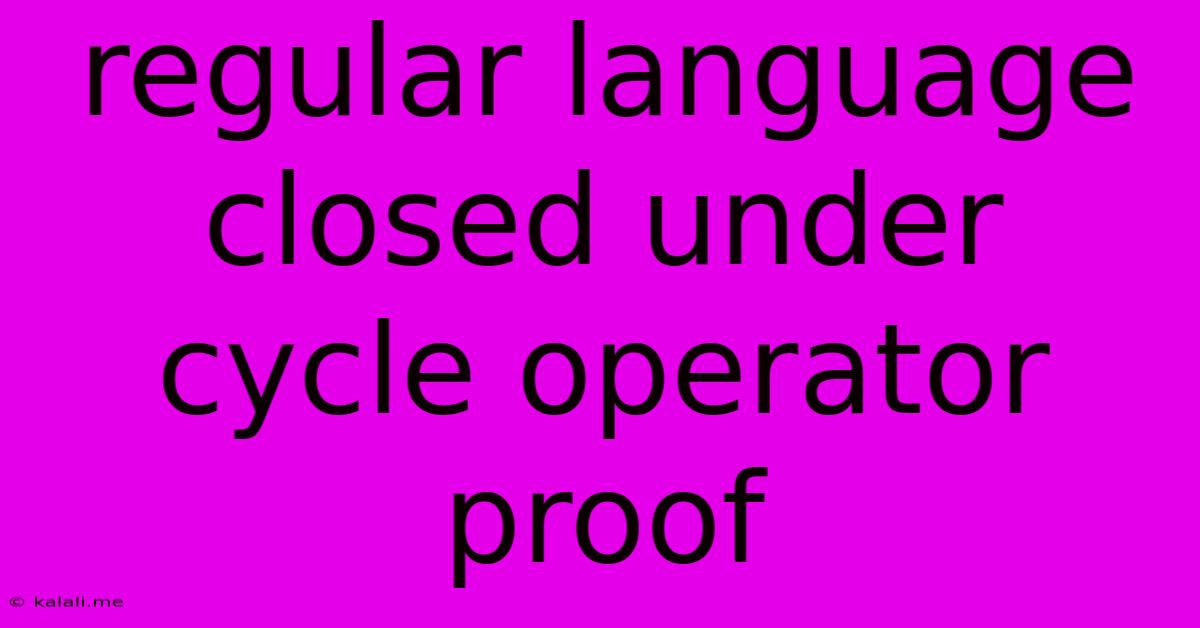Regular Language Closed Under Cycle Operator Proof
Kalali
May 23, 2025 · 3 min read

Table of Contents
Regular Languages are Closed Under the Cycle Operator: A Formal Proof
This article provides a formal proof demonstrating that regular languages are closed under the cycle operator. Understanding this closure property is crucial for comprehending the theoretical limits and capabilities of finite automata and regular expressions. We'll explore the concept of the cycle operator, define regular languages, and then present a rigorous proof. This is essential knowledge for anyone working with formal language theory, compiler design, or automata theory.
The cycle operator, denoted by C, transforms a string w into all its cyclic permutations. For example, if w = "abc", then C(w) = {"abc", "bca", "cab"}. A language L is closed under the cycle operator if for every string w in L, all cyclic permutations of w are also in L.
Regular Languages: A language is considered regular if it can be described by a regular expression or accepted by a deterministic finite automaton (DFA). These are fundamental concepts in the study of formal languages. DFAs are particularly useful for proving closure properties.
Proof Strategy: We will prove this closure property by demonstrating that if a language L is regular (accepted by a DFA), then the language C(L) (the language formed by applying the cycle operator to all strings in L) is also regular (also acceptable by a DFA).
Constructing a DFA for C(L):
Let's assume L is a regular language accepted by a DFA M = (Q, Σ, δ, q₀, F), where:
- Q is a finite set of states.
- Σ is the input alphabet.
- δ: Q x Σ → Q is the transition function.
- q₀ ∈ Q is the initial state.
- F ⊆ Q is the set of accepting states.
We'll construct a new DFA M' that accepts C(L). The construction of M' is the core of this proof and requires a careful approach. The key idea is to create states in M' that represent the possible prefixes of cyclic permutations of strings in L.
-
States of M': The states of M' will be subsets of Q x Q. Each state (qᵢ, qⱼ) represents the situation where we have processed a prefix of a string that ends in state qᵢ, and if we were to complete the cycle, we would reach the state qⱼ (i.e., the remaining suffix would lead from qᵢ to qⱼ in M).
-
Initial State of M': The initial state of M' is {(q₀, q) | q ∈ Q}. This means we start at the initial state q₀ of M, and we consider all possible states that we could reach by completing a full cycle.
-
Transition Function of M': The transition function δ': (Q x Q) x Σ → (Q x Q) is defined as follows:
δ'({(qᵢ, qⱼ) | i, j ∈ Q}, a) = {(δ(qᵢ, a), qⱼ) | (qᵢ, qⱼ) ∈ {(qᵢ, qⱼ) | i, j ∈ Q}} for all a ∈ Σ.
In essence, this transitions from one set of (qᵢ, qⱼ) pairs to another by applying the transition function δ of M to the first component of each pair, keeping the second component unchanged.
-
Accepting States of M': A state S ⊆ Q x Q in M' is accepting if and only if there exists at least one pair (qᵢ, qⱼ) ∈ S such that qᵢ = qⱼ and qᵢ ∈ F. This means that we have successfully completed a cycle (qᵢ = qⱼ) and reached an accepting state (qᵢ ∈ F) in M.
Why this works: The constructed DFA M' systematically explores all possible cyclic permutations of strings in L. By checking if a cycle can be completed and reaches an accepting state in M, M' correctly accepts all strings belonging to C(L). The finite nature of Q guarantees that the set of states in M' is also finite.
Therefore, since we have constructed a DFA M' that accepts C(L), we conclude that regular languages are closed under the cycle operator. This proof highlights the power and elegance of using finite automata to reason about the properties of regular languages.
Latest Posts
Latest Posts
-
How Many Cups Is 1 Pound Of Cheese
Jul 12, 2025
-
30 X 30 Is How Many Square Feet
Jul 12, 2025
-
How Much Does A Half Oz Weigh
Jul 12, 2025
-
Calories In An Omelette With 3 Eggs
Jul 12, 2025
-
How Do You Say Great Grandmother In Spanish
Jul 12, 2025
Related Post
Thank you for visiting our website which covers about Regular Language Closed Under Cycle Operator Proof . We hope the information provided has been useful to you. Feel free to contact us if you have any questions or need further assistance. See you next time and don't miss to bookmark.